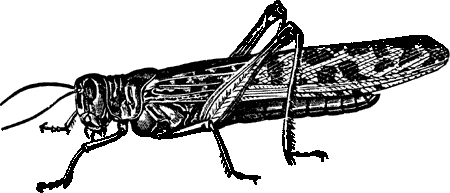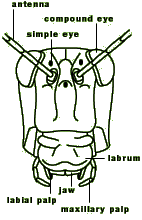
The Head

The head of the grasshopper has five segments. The first segment is free of appendages and has two compound eyes and three simple, rather small eyes. The compound eyes have a wide field of vision because they account for a relatively large area on the grasshopper's face and curve around the sides of the head. These big eyes also contribute to the bug's freaky up-close appearance. The second segment of the grasshopper's head bears it's pair of sensory antennas which are jointed and long and rather attractive. The third segment bears the upper lip of the grasshopper. The fourth segment of the head has a pair of toothed, spiney jaws called mandibles. The fifth and final segment is indicated by a pair of accessory jaws called maxillas each with a jointed sensory palp. The labium of the adult appears as a singular plate. Much, perhaps all of the grasshopper's food intake is facilitated by these various mouth parts working together. When using these mouth parts properly, the grasshopper can breakdown plant parts to be swallowed inside for digestion as food. This breakdown is often referred to as chewing.